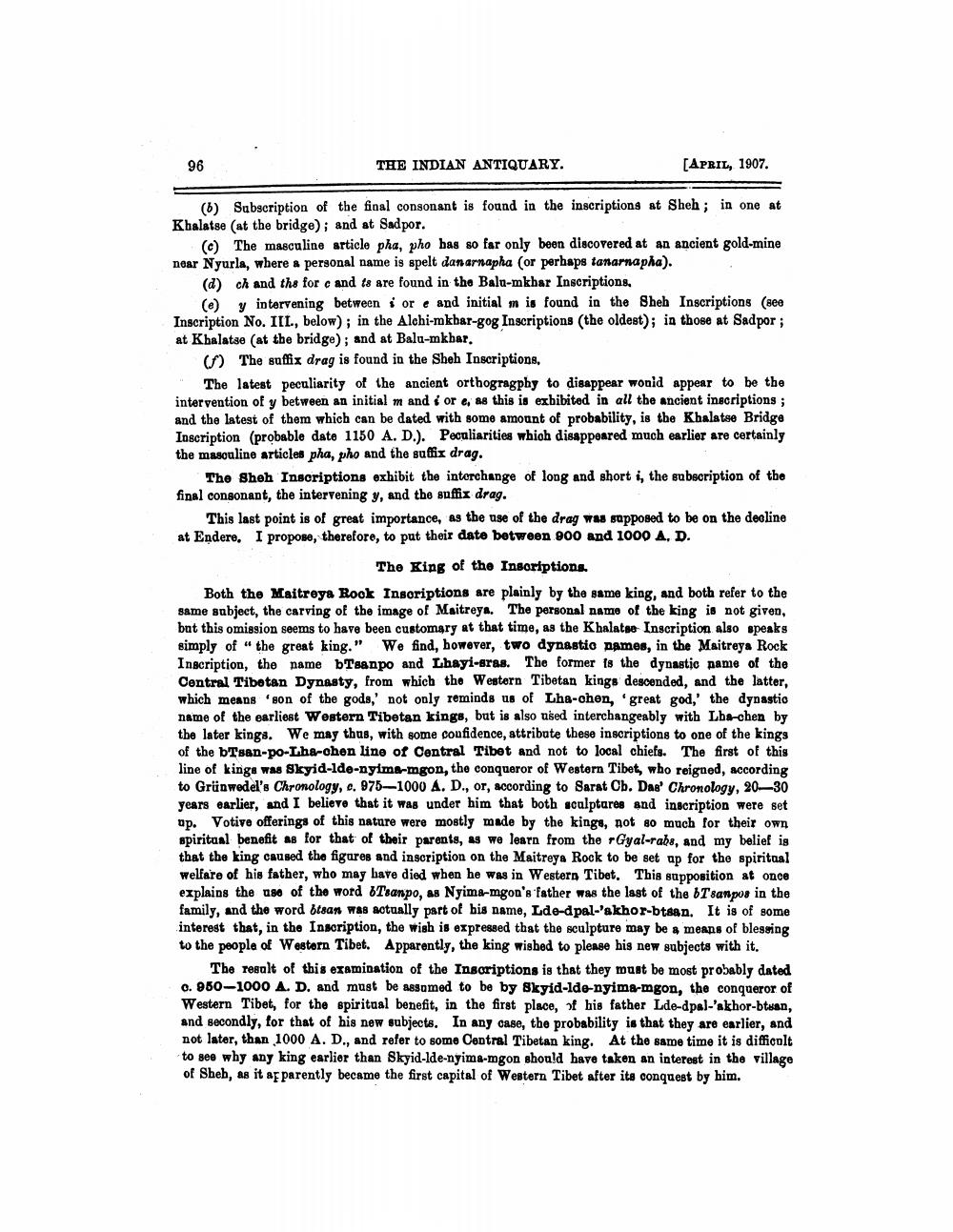________________
96
THE INDIAN ANTIQUARY.
[APRIL, 1907.
(6) Subscription of the final consonant is found in the inscriptions at Sheh ; in one at Khalatse (at the bridge); and at Sadpor.
© The masculine article pha, pho has so far only been discovered at an ancient gold-mine near Nyurla, where a personal name is spelt danarnapha (or perhaps tanarnapha).
(d) ch and the fore and ts are found in the Balu-mkbar Inscriptions,
(e) y intervening between i ore and initial m is found in the Sheh Inscriptions (see Inscription No. III., below); in the Alchi-mkbar-gog Inscriptions (the oldest); in those at Sadpor; at Khalatae (at the bridge); and at Balu-mkbar.
( The suffix drag is found in the Sheh Inscriptions,
The latest peculiarity of the ancient orthogragphy to disappear would appear to be the intervention of y between an initial m and i ore, as this is exbibited in all the ancient inscriptions ; and the latest of them which can be dated with some amount of probability, is the Khalatse Bridge Inscription (probable date 1150 A. D.). Peculiarities which disappeared much earlier are certainly the masculine articles pha, pho and the suffix drag.
The Sheh Inscriptions exhibit the interchange of long and short i, the subscription of the final consonant, the intervening y, and the suffix drag.
This last point is of great importance, as the use of the drag was supposed to be on the decline at Eņdere. I propose, therefore, to put their date between 900 and 1000 A, D.
The King of the Insoriptions. Both the Maitreya Rock Inscriptions are plainly by the same king, and both refer to the same subject, the carving of the image of Maitreya. The personal name of the king is not given, but this omission seems to have been customary at that time, as the Khalatse Inscription also speaks simply of the great king." We find, however, two dynastio names, in the Maitreya Rock Inscription, the name bТsanpo and Lhayi-eras. The former is the dynastic name of the Central Tibetan Dynasty, from which the Western Tibetan kings descended, and the latter, which means son of the gods,' not only reminds us of Lha-chen, great god,' the dynastic name of the earliest Western Tibetan kings, but is also used interchangeably with Lha-chen by the later kings. We may thus, with some confidence, attribute these inscriptions to one of the kings of the bТsan-po-Lha-chen line of Central Tibet and not to local chiefs. The first of this line of kinga was Skyid-ide-nyima-mgon, the conqueror of Western Tibet, who reigned, according to Grünwodel's Chronology, e. 975--1000 A. D., or, according to Sarat Cb. Das' Chronology, 20–30 years earlier, and I believe that it was under him that both sculptures and inscription were set up. Votive offerings of this nature were mostly made by the kings, not so much for their own spiritual benefit as for that of their parents, as we learn from the rGyal-rabs, and my belief is that the king caused the figures and inscription on the Maitreya Rock to be set up for the spiritaal welfare of his father, who may have died when he was in Western Tibet. This supposition at once explains the use of the word Tranpo, as Nyima-mgon's father was the last of the Tsanpus in the family, and the word btsan was actually part of his name, Lde-dpal-akhor-btsan. It is of some interest that, in the Inscription, the wish is expressed that the sculpture may be a means of blessing to the people of Western Tibet. Apparently, the king wished to please his new subjects with it.
The result of this examination of the Inscriptions is that they must be most probably dated .960-1000 A. D. and must be assomed to be by Skyid-ide-nyima-mgon, the conqueror of Western Tibet, for the spiritual benefit, in the first place, of his father Lde-dpal-'akhor-btsan, and secondly, for that of his new subjects. In any case, the probability is that they are earlier, and not later, than 1000 A. D., and refer to some Central Tibetan king. At the same time it is difficolt to see why any king earlier than Skyid-Ide-nyima-mgon should have taken an interest in the village of Sheh, as it af parently became the first capital of Western Tibet after its conquest by him.




